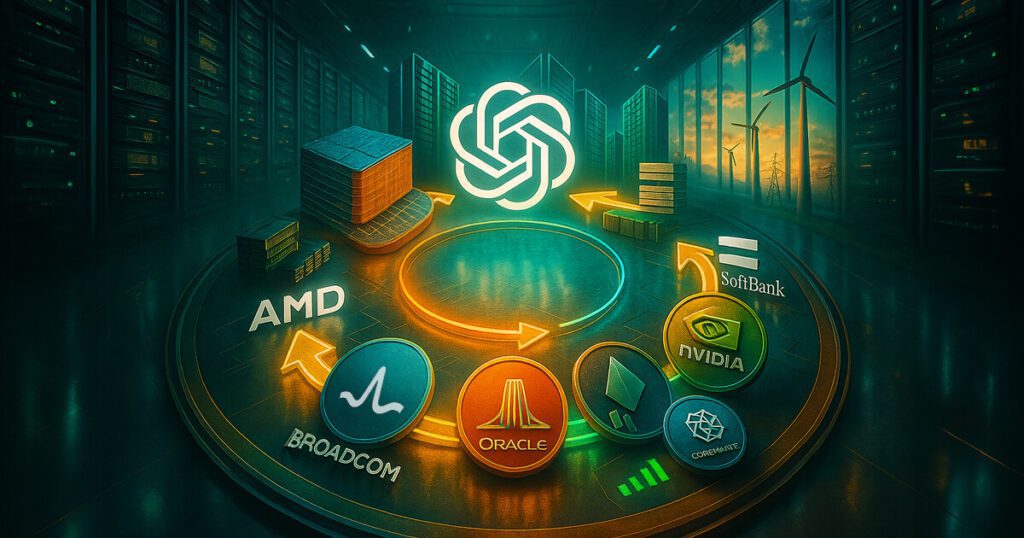OpenAI has embarked on a $300 billion hardware expansion that will connect chip suppliers, financiers, and energy providers into a single feedback loop.
The company has signed multi-year agreements with AMD and Broadcom to deliver tens of millions of AI accelerators from 2026 to 2029, representing a combined approximately 16 gigawatts of new computing power, enough to match the entire electricity usage of some small countries.
AMD will supply 6 gigawatts of Instinct GPUs and grant OpenAI stock warrants tied to performance milestones, while Broadcom will co-design and deploy 10 gigawatts of custom silicon and rack systems during the same period.
These agreements build on Oracle and SoftBank’s Stargate build-out, a five-location U.S. expansion plan with cumulative spending of more than $300 billion and the backbone of the largest privately funded infrastructure project in the history of technology.
Circular AI economy
The structure of these contracts illustrates a circular economy pattern in AI infrastructure, where capital, equity incentives, and purchase obligations are interlocked between vendors, infrastructure providers, and model operators.
AMD’s deal ties future GPU deliveries to milestone-based guarantees, gives OpenAI upward exposure to AMD’s stock performance, and creates a feedback loop between supplier evaluations and customers’ capacity expansion paths.
In parallel, Nvidia disclosed a roughly 7% stake in CoreWeave earlier this year, while CoreWeave expanded its contract with OpenAI by $6.5 billion, bringing the total contract to around $22.4 billion in 2025, which combines the chip vendor’s capital, infrastructure lender’s revenue, and OpenAI’s computing consumption in the same chain.
Bloomberg also reported on vendor funding loops, including up to $100 billion in Nvidia commitments related to chip purchases by OpenAI, revealing demand optics that are partially funded by suppliers themselves.
The forward-looking view turns on three execution gates: utilization, energy, and cost curves. In terms of utilization, capacity growth announced by AMD, Broadcom, and Stargate will collectively reach the double-digit gigawatt range through 2029, but enterprise AI revenues will need to scale to maintain cluster occupancy above threshold levels that support attractive revenues.
BofA’s October survey found that 54% of fund managers called AI a bubble and cash balances stood at nearly 3.8%, with the potential for greater volatility across the market if implementation falls behind delivery schedules.
With the “Magnificent Seven” hovering around one-third of the S&P 500 market capitalization by mid-2025, index concentration adds another macro channel and increases passive portfolio sensitivity to changes in AI news flows and capital investment guidance.
AI energy needs
Energy, grid availability, and delivery cost per megawatt hour determine the feasible pace of model scaling.
Goldman Sachs predicts that global data center power demand will increase by approximately 165 percent by 2030 compared to 2023. This trajectory will push data center operators toward long-term power purchase agreements, on-site generation, and relocation as new clusters come online from 2026 to 2029.
According to a McKinsey report cited throughout the trade press, the US trajectory is at a compound growth rate of approximately 25% through 2030, and US data centers could consume more than 14% of the nation’s electricity by the end of the decade, increasing the risk of the plan if interconnection queues and permitting schedules extend relative to hardware deliveries.
Regulatory lanes remain in flux, but the UK Competition and Markets Authority concluded in March 2025 that the Microsoft-OpenAI partnership is not subject to a merger investigation, and the criteria could be revisited if new stock-related supply arrangements raise concerns about market power around access and pricing.
Custom silicon is a cost lever to watch as Broadcom’s programs move from design to deployment.
If co-design efforts of accelerators, networking, and racks improve real performance per watt, commodity inference costs and training efficiencies can reset the unit economics of a circular model to self-funded cash flows as utilization increases.
With execution risks in toolchain, packaging, and memory bandwidth, with timelines starting in the second half of 2026 and ramping up over multiple years through 2029, vendor and operator financial outcomes will track the speed at which those benefits appear in audited margins and contract prices.
The immediate map of commitments is clear, with near-term checkpoints being the translation of framework deals disclosed in vendor filings and press updates into firm purchase orders.
CoreWeave’s funding and deal flow, including its corporate activities and Nvidia’s ownership transition, illustrates how tight the loop between supplier capital, infrastructure capacity, and OpenAI’s demand path is.
Apple’s system-level integration in 2024 expanded consumer surface area with privacy terms such that requests are not stored by OpenAI and IP addresses are hidden. This counters enterprise adoption cycles that tend to be based on compliance and ROI milestones rather than just device reach.
The portfolio and financial planning question is how the announced gigawatts match actual workload growth, regional power availability, and cost trajectory through 2028. A practical way to track the transition from circular to sustainable is to combine data center utilization metrics with a combination of energy contract coverage and revenue from usage-linked corporate contracts.
As these measures improve as the second half of 2026 rolls out, the funding loops built into these deals will serve as bridge funding to a more stable computing economy, rather than as a source of correlation risk between vendors, infrastructure providers, and labs.
Capacity Partner Initial Deployment Goal Completed Note 6 GWAMD2H26N/AM Up to 160M AMD Shares Guaranteed on Milestone Basis, 10 OpenAI Beneficiaries GWBroadcom2H26 End of 2029 Custom Accelerators and Racks Co-Designed with OpenAI 4.5-5.5 GWOracle, SoftBankPhasedN/A 5 New US Stargate Sites, Partnership Language Exceeds $300B for over 5 years
The period from when the first Broadcom systems and AMD waves come online, to power contracts being completed at Stargate sites, and to revenue-backed consumption growth through enterprise channels, is concentrated in 24-36 months. OpenAI says Broadcom’s deployment will be finished by the end of 2029.



